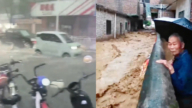【新唐人2013年12月19日訊】長江是中國和亞洲的第一大河,中國的「三峽水壩工程」完工後,長江流域最大的水利工程就是「南水北調」。日前專家指出,三峽和南水北調工程,嚴重破壞了長江的生態,目前,長江缺水現象嚴重,江裡已經無魚可捕。
中共耗資5000億元人民幣投入的「南水北調工程」,是長江流域最大的水利工程,工程規模和難度,超過「三峽水壩工程」,但是,專家評估認為,工程對於長江流域的環境,將造成「浩劫」。
「南水北調」的構想,是把長江流域的水資源抽調一部分,送到華北和中國西北,從而改變中國「南澇北旱」的現象,和北方地區水資源嚴重短缺的局面。工程分為東線、中線和西線三條線路。
大陸媒體《瞭望東方週刊》日前報導﹕「三峽、南水北調工程影響生態,長江無魚可捕。週刊專訪科學院院士曹文宣,他是目前中國資歷最老的長江生態系統專家之一。」
曹文宣在專訪中列舉了近年來為保護長江生態而進行的一系列努力,但他評價「效果都不是很大」,具體表現在,國家一級重點保護動物—-白鰭豚,已經「功能性絕滅」 另一種一級保護動物—-白鱘,已經10年不見蹤影。
而長期關注三峽工程的中國環保活動人士戴晴指出,自從「三峽工程」的泥沙問題提出來之後,當局開始在長江的上游築壩,築了壩,欄了沙,同時也欄了水,於是就造成了長江水短缺。戴晴說,這一事實被當局給隱瞞了。
中國環保活動人士戴晴:「本來大自然安排的好好的,河流流過甚麼地方,那個地方應該有甚麼樣的農業,然後那面的人是以甚麼樣的生活,可是,人類以為自己掌握了技術,有了一點小小的技能,就完全按照自己怎麼樣得到更多的利益,就來改變自然。」
2001年,北京取得2008年奧運會的舉辦權,為了給「北京奧運會」提供水源,時任黨魁的江澤民立即批准「南水北調工程」,並在隔年的2002年年底正式開工。
但是工程進展一直不順利,因為工程違背可持續發展的基本原理,而大量移民人數大大超過了規劃。因此,儘管投資一再追加,工期卻一推再推。2008年北京奧運會就沒有喝上「南水北調工程」的水。
戴晴:「南水北調現在說的好聽,其實我們大家都知道,中線的南水北調是非常緊缺的,這個水,不能說百分之百無水可調,但是想用南水北調中線的水,來解決北京的水短缺,用我的觀點幾乎是沒有可能的。」
曹文宣在專訪中表示,「南水北調西線」對長江上游的生態環境影響會更大。相對而言,長江上游的生態系統更為脆弱,水源區的生產、生活都會受到影響,需要慎重對待。他還說﹕「南水北調中線」的工程「影響大」。
分析指出,「南水北調中線工程」現在面臨的最大技術問題,就是「水源地的水量不足」,水位不夠高,無法滿足調水和自流要求。
而正當中共中央和國務院面對「南水北調工程」水源不足的問題束手無策時,中共國家發改委卻又在2011年7 月,批准了陝西「引漢濟渭工程」,也就是引漢江水向渭河調水,規劃每年可調15億立方米水。
曹文宣認為,「引漢濟渭」工程,要把漢江三分之一的水量調往北方地區,漢江中下游的水量則大量減少,而現在漢江的水已經不多了。」
旅居德國的中國水利專家王維洛則認為,「南水北調各線工程」都將對長江的中下游環境造成浩劫性的影響。例如東線工程調水,將導致長江河口地區的土壤鹽漬化等問題,而中線工程則將造成武漢、湖北地區難以估量的損失。
戴晴則認為,中共前黨魁毛澤東說的「人定勝天」,結果導致中國目前到處出現自然災害,而這些災害,歸根到底都是人類自己造成的。
採訪編輯/常春 後製/孫寧
Natural Disasters Inflicted By The Water Diversion Project
The Yangtze River, is the largest river in China and Asia.
After the Three Gorges Dam construction, the river is now
undergoing the massive infrastructural Water Diversion Project.
Experts have recently pointed out that both the
construction of dams and the Water Diversion have severely
damaged the ecology of the Yangtze River.
The Yangtze River is running short on both water and fish.
The South-to-North Water Diversion is a 500 billion yuan
project of the Communist regime.
It is the largest water project with the scale and complexity
far exceeding that of the Three Gorges Dam.
The environmental impact assessment shows the project is
bringing catastrophe to the Yangtze River.
The Water Diversion Project was to divert part of the Yangtze
River water to the north and northwest;
the drought area of China.
The project includes a Western, a Central and an Eastern route.
The Oriental Outlook magazine recently reported in an interview
with China’s senior ecologist, Cao Wenxuan, of the Institute of
Hydrobiology at the Chinese Academy of Sciences.
Cao Wenxuan listed the series of efforts in recent years
to protect the ecology of the Yangtze River, and their
effectiveness as “not good."
Examples are: Rare fish such as the Yangtze dolphin is
functionally extinct,
and the Chinese sturgeon has disappeared for 10 years.
Dai Qing is an environmentalist having long-term observed
China’s Three Gorges Dam.
She indicates that since the sediment matter of the
Three Gorges Dam was silted up,
the regime started to build a dam in the upper reaches of the
Yangtze River to block the sand and silts, but also the water.
That has caused the water shortage of the Yangtze River,
and “a fact concealed by the authorities,” says Dai Qing.
Dai Qing, environmentalist: “Nature had arranged it well
at the beginning, where the water should flow, what type of
agriculture to develop, and life style of the people.
With technology, human beings thought they can manage it
the way they’d like to and so they started to change nature."
In 2001, Beijing received the hosting rights for the 2008
Olympic Games.
To provide water for the Beijing Olympics, the then Communist
party leader Jiang Zemin immediately approved the Water
Diversion Project to be started by end of 2002.
The project has met many obstacles because of violating the
principles of sustainable development and
the exceedingly large population of migrants.
There were constant budgetary over-runs,
constant delays and postponements.
The water from the project never made it to
the 2008 Beijing Olympic Games.
Dai Qing: “The Water Diversion sounds nice. But we all know
the fact that the water in the Central Route is very scarce.
There is water to be diverted, but to solve the water shortage
in Beijing, to me it is almost impossible."
Cao Wenxuan indicated in the interview that the Western Route
will have an even bigger impact on the ecosystem of the
upper reaches of the Yangtze River.
It will further weaken the ecosystem and affect productivity
and life in the reservoir.
He added, “The Central Route will have a major impact.”
Analysis has pointed out that the biggest technical problem of
the Water Diversion is insufficient water in the reservoir.
The water level is so low that it can not sustain
diversion and natural flow.
While no solution to this water shortage of the Water
Diversion Project has been found,
the Communist regime approved yet another water diversion
project in July 2011.
The Han-Wei Water Diversion Project in Shaanxi Province
will move water from the Han to the Wei River and by 2030
will be drawing 15 billion cubic metres of water from
the reaches of the Han River.
Cao Wenxuan said, “The Han-Wei Water Diversion will divert
one-third of Han River water to the north.
The water in the middle and lower reaches of the Han River
has reduced significantly.
Han River has not much water left.”
Water expert Wang Vero believes that the overall water
diversion projects are an environmental catastrophe to the
middle and lower reaches of the Yangtze River.
For instance, the Eastern Route will lead to soil salinization
in the Yangtze River estuary region, and the Central Route
will bring incalculable damages to Hubei Province.
Dai Qing stresses that, former Communist Party leader
Mao Zedong’s “Man Will Conquer Nature” has led to wide-
spread natural disasters in China.
All these natural disasters, as it turns out,
are man made.
Interview & Edit/Chang Chun Post-Production/Sun Ning




























